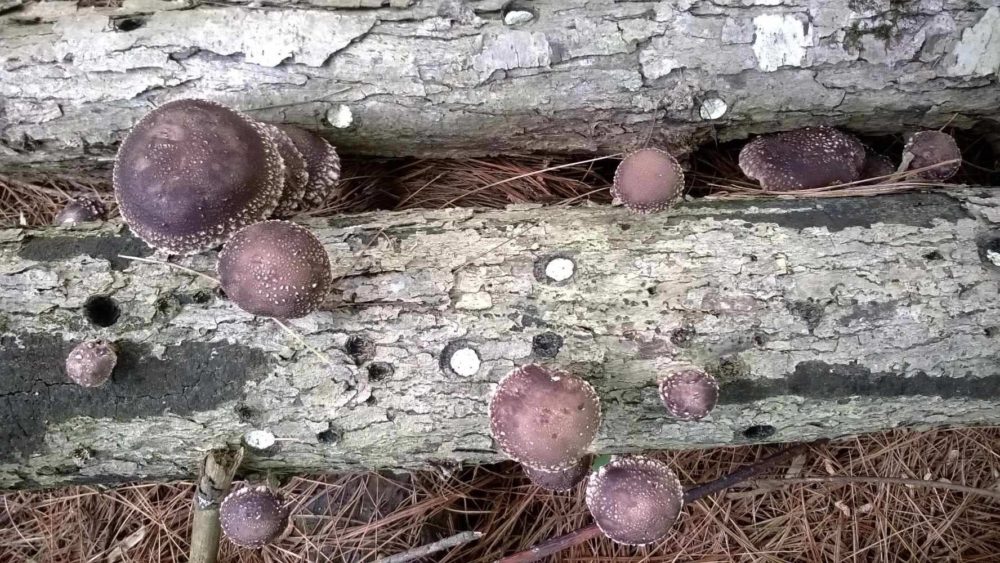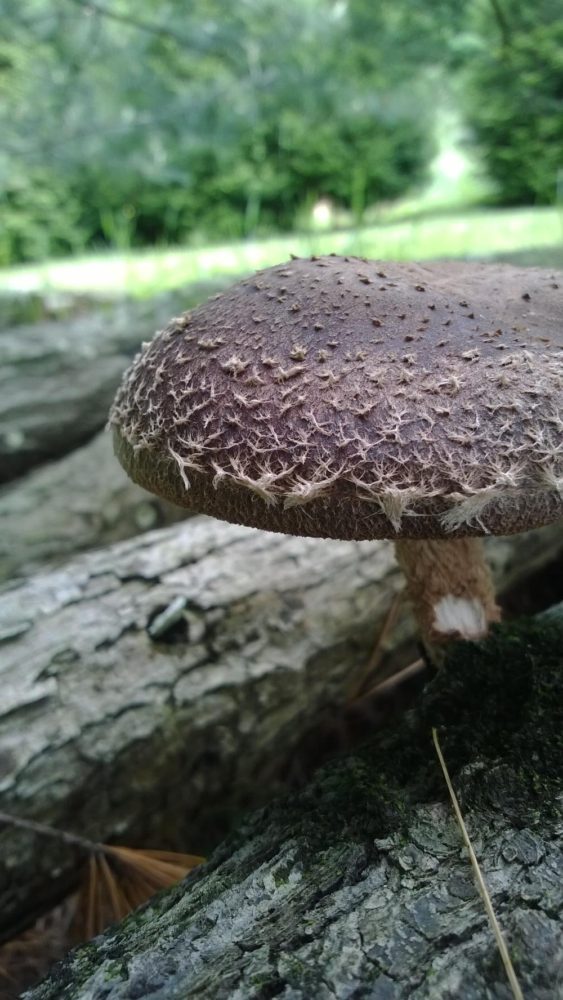By Eric Soderholm, Organic Production Coordinator

If you own a woodlot and have considered the possibility of raising shiitake mushrooms on logs, now is an excellent time to take a winter stroll in the woods and along the edges of your fields to assess the possibilities.
The name shiitake comes from Japan, where these mushrooms were traditionally cultivated. Shii is the name of the tree that is often used as the medium to grow them, a relative of our oak and beech trees, while take is Japanese for mushroom.
The first record of this practice dates back to 199 AD. Currently, the majority of shiitakes that are sold in the U.S. come from compressed sawdust production. I believe that raising them in the more traditional fashion yields a superior mushroom that is attractive and has better flavor. It also can provide the opportunity to get some cash flow from your forest land with market prices as high as $16/lb for direct market sales and $9/lb wholesale for fresh log-grown shiitakes.
Timing
Typically, shiitake logs are cut from living trees in winter/early spring of the year when daytime temperatures are in the 50s, but nighttime temperatures are still freezing. This is when the trees’ sap has begun moving upward from its winter storage in the roots and thus yields a stronger food supply for our desired fungus.
In every step of preparing shiitake logs, be mindful of ways you might be making your logs vulnerable to colonization by unwanted species of fungus. This is just like reducing weed pressure in the garden; unwanted fungi will compete with your shiitakes if you give them the right conditions!
For this reason, it is important to start with green wood that is not already colonized by other fungi. Green wood also provides a high moisture content that aids shiitake mycelium establishment and provides a longer-lasting source of food source since it has not yet begun to decompose.
Let’s Talk Logs
For easy handling, most growers will harvest logs about 3-6″ in diameter and 3-4 ft in length. Logs that are larger than this can be cumbersome, especially after they have taken on water weight from soaking to encourage fruiting.
Soaking logs for 24 hours is a common practice to produce a reliable “flush” of mushrooms and is typically done in a rotation so that no logs are soaked more than once every five weeks during the growing season. But let’s not get ahead of ourselves…
Raising (shiitake) in the more traditional fashion yields a superior mushroom that is attractive and has better flavor.
Oak logs, especially those in the white oak group, are the preferred species. They decompose slowly, providing several years of food for the shiitakes–thus offering a longer harvest period. With ideal conditions, logs are typically kept in production for three seasons and, over that period, yield an average of 1.5 lbs of mushrooms per log per year. However, other hardwoods like beech, cherry, birch, ash, and hickory can be used but offer a shorter productive life span. Black locust should not be used because it produces strong anti-fungal compounds. In fact, all trees naturally produce them (at lower levels) to prevent fungal parasitism. To reduce this effect, it is best to let cut green logs (with branches left intact, if possible) sit for about two weeks, allowing these compounds to dissipate before inoculating logs with shiitake spawn.

It is also important that logs not sit idle too long, especially if they are cut in the spring,
To get a substantial quantity of logs, you may choose to harvest from a wide range of sources. Small-diameter pole trees are an easy target, and thinning them, in some cases, may benefit the larger stand overall. The tops of large-diameter trees that have been felled for firewood or were naturally blown down in winter storms can be an excellent source. If you raise crops, you might consider identifying and cutting trees along your fields’ edges that shade growing areas and compete with crop roots for moisture and nutrients. Because the labor time that goes into raising log-shiitakes will be one of your greatest costs, it is important to be efficient and let the harvest of logs serve multiple purposes for your operation/household when possible. When cutting logs, it is critical that you handle them gently to avoid injury and loss of bark, which invites undesired fungi to creep in.
Because the labor time that goes into raising log-shiitakes will be one of your greatest costs, it is important to be efficient and let the harvest of logs serve multiple purposes for your operation when possible.
Want more? See my follow-up tip on Shiitake Mushroom Spawn Selection and Log Inoculation, which picks up where we’re leaving off. I give my thoughts on sources and types of shiitake spawn, inoculating your logs, and recommended practices for stacking, protecting, and soaking logs as well as storing and marketing the mushrooms.
All images courtesy of Amy Miller, Barefoot Farm (Barnardsville, NC)


